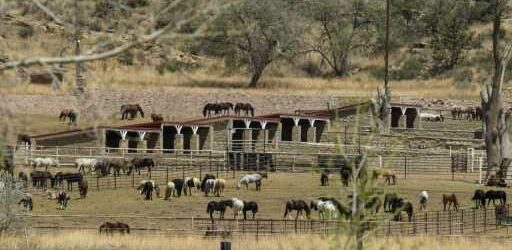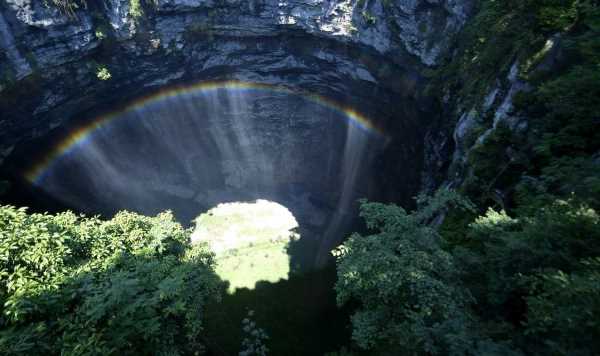CANON CITY — A rising death toll of captive wild horses in fenced pens has hit 142 after federal caretakers failed to provide vaccinations in the latest breakdown of the government’s controversial holding system. The debacle has piqued concerns about humane treatment as the Bureau of Land Management ramps up roundups to reduce mushrooming Mustang herds that roam free — along with cattle and sheep — on increasingly arid public lands.
BLM officials told the Denver Post they’ll investigate why 445 horses hauled from northwestern Colorado to Canon City last summer weren’t fully vaccinated against equine flu.
Surviving chestnut, bay and painted Mustangs this week wandered about the pens, which cover about 50 acres within a 120-acre holding facility next to a state prison — 2,550 horses in all. The respiratory sickness has infected primarily the unvaccinated horses and they are the ones dying.
Veterinarians said not much can be done to prevent more deaths as flu and follow-on bacterial infections take their course.
The outbreaks and die-offs here and at a BLM facility in Wyoming intensified a long-running struggle over how to handle the West’s wild horses, or Mustangs, descendants of horses Spanish settlers introduced, as hotter, drier conditions reduce grass and water horses need to survive in the wild.
The wild horse and burro population across 10 states has more than doubled over the past decade to 82,384, according to BLM data from aerial surveys. That’s triple the agency’s target of 26,715 that BLM officials say the land can sustain. In Colorado, the population hovers around 1,689, more than twice land managers’ target of 827.
“A broken system”
For the past two years, BLM teams have been gathering and removing more horses. They’re preparing to capture 22,000 Mustangs this summer — including a herd in Colorado near Meeker — and place them into their network of 28 holding facilities, including the one at Canon City. More than 60,000 Mustangs now are held in captivity nationwide, up from 50,935 a decade ago, data show. The overall cost to taxpayers of managing wild horses has increased from $71 million a year in 2013 to $137 million this year.
“Wild horses are safest in the wild. We cannot keep piling wild horses into a broken system,” said Scott Wilson, a Denver-based board member for the American Wild Horse Campaign, who urged an immediate end to round-ups and greater reliance on birth control to keep horses free.
“When we confine wild horses, these kinds of disease outbreaks are set up. We’re confining these horses at their peril,” Wilson said. “We’re supposed to be protecting them. They’re national treasures.”
Animal rights advocates are exploring a lawsuit around the failure to vaccinate and standards of care at holding facilities.
Even with vaccinations, eleven horses died since March at the BLM holding facility in Wyoming where an outbreak of “strangles” (streptococcus equi) has infected roughly half the 2,750 captive horses. Horses that arrived in 2021 were starting to receive booster shots against strangles, “one of the vaccines that all horses that are processed through the BLM off-range program receive,” agency spokesman Brad Purdy said.
If wild horses remain free, their herds grow by 15% to 20% a year, potentially doubling every five years depending on the effectiveness of birth control. BLM officials disputed the assertion that horses are safer roaming public lands. Last year, dried-up water pools and disappearing grass for foraging forced emergency crews to rescue 7,000 horses, BLM spokesman Brian Hires said at headquarters in Washington D.C.
“Chronic wild horse overpopulation in desert and sagebrush ecosystems that tend to have scarce resources like forage and water puts the overall health of the land and herd at risk, with the possibility of permanent, irrecoverable damage,” Hires said. “As climate change drives more frequent and extreme drought events across the West, the impacts of overpopulation on rangeland and animal health will be amplified. The damaging impacts of drought will further reduce availability of water and forage for wild horses and wildlife, especially in areas of public lands where wild horses and burros are severely overpopulated.”
Disease outbreaks causing as many deaths of captive horses as the one that began April 23 in Canon City have been rare, Hires said, acknowledging that sickness can spread rapidly when horses are concentrated in pens. BLM officials have declared quarantines at both facilities and said employees will monitor sick horses, treating them where possible given that Mustangs can be difficult.
Animal rights advocates contend a reduction in cattle and sheep grazing on BLM land would allow more horses to roam, and they advocate increased use of birth control shots that wear off every two years as preferable for keeping horse populations sustainable.
BLM officials declined to discuss their operations in Canon City and why the West Douglas herd hauled from western Colorado last summer wasn’t fully vaccinated.
“We are conducting a review on how that came to be the situation,” BLM Colorado spokesman Steven Hall said in an email.
“Temporary” captivity
That review also will consider “why these horses are being particularly affected,” Hall said. BLM bulletins said this herd was “displaced” by the Oil Springs wildfire that burned 12,613 acres north of Grand Junction in June 2021. BLM teams in July and August conducted a roundup using helicopters and trained horses that led wild horses into a pen where they were loaded onto trucks.
Captivity in Canon City is meant to be “temporary.” The facility is run in partnership with the Colorado Department of Corrections with prison inmates conducting the work of feeding and caring for wild horses. The program began in 1985 and has expanded to hold as many as 2,950 horses, state officials said. Four state employees and an inmate workforce of 22 handle the horses under BLM supervision.
But captive horses languish here for up to at least nine months. Some eventually are moved to pastures for unwanted horses in Oklahoma, Nebraska, Kansas and other grassy states.
A few are adopted. BLM officials offer $1,000, paid after new homes and care pass inspections.
Need for adoptions
Last fall, photographer and former psychologist Carol Walker, who raises horses on her 40 acres near Longmont, applied. She’d taken a photo of a wild horse and her foal on BLM land in Wyoming’s Red Desert. Then, when she heard about a roundup, she persistently tracked the foal. It had been hauled to Canon City.
When she went to adopt it in August 2021, she took a photo showing an under-weight horse with its ribs showing. She named it Helios. She tried to contact Gov. Jared Polis, requesting an investigation of the conditions at what appeared to be an overcrowded, understaffed facility.
She and fellow horse advocates sent a letter to Polis warning of “potential animal neglect,” calling for a review “to ensure wild horses are not subject to neglect or harm needlessly.” They cited legal requirements for humane treatment under the Wild Free-Roaming Horses and Burros Act of 1971, animal welfare laws and BLM rules for care of captive horses.
“This is an animal welfare and animal cruelty issue,” Walker said last week as the death toll rose in Canon City. “You put a whole bunch of horses in a small area. They get stressed. They get sick. And now, with all these horses dying and sick, you’re going to go gather another 1,000 horses and put them in this crowded facility?”
The BLM’s facility manager, Steve Leonard, who also oversees BLM wild horse operations statewide, wasn’t available and a clerk at his office said she’d been given directions to refer all queries to the agency’s designated spokesman. The spokesman declined to speak or make officials available, only responding to written questions by email.
Walker said Leonard later visited to inspect Helios and found the horse’s health had improved.
“We need more people to adopt wild horses,” said Sarah King, a Colorado State University research scientist specializing in managing wild horses, who conducted work on hard-hit habitats in Nevada last year and favors mass castration of males in addition to more birth control for females.
“The land is getting hotter and drier with this unprecedented level of drought. Definitely, water sources are beginning to dry out,” King said. “Some form of management is needed because the wild horse populations can grow so fast. That’s why, at the moment, the BLM is really focusing on removals — getting horses off the range.”
Treating the symbol of the West humanely
Congress has declared Mustangs protected as a symbol of western culture. Wild horse advocates contend prehistoric horses originated in North America and call them a “returned native species” on land that evolved with horse-like creatures foraging. BLM officials characterize Mustangs as non-native “modern horses” introduced by European settlers.
Euthanizing wild horses is prohibited. BLM caretakers, in their latest report to Congress, said they would prioritize roundups and also use birth control to reduce numbers — managing to also sustain cattle and sheep grazing and other wildlife with “healthy horses on healthy land.”
Humane treatment at holding facilities should include prompt vaccinations of captive horses as soon as they settle after the trauma of relocation, said Canon City veterinarian Pam Rose, who had visited the facility here in the past. Concentrating 2,550 horses in fenced pens “is not natural,” Rose said. “It is like kids in daycare. If one kid gets sick, they all get it. The virus has to go through anyone who’s not immune.”
CSU extension veterinarian Ragan Adams, an equine disease specialist, said dealing with the West’s wild horses looms as an “incredibly difficult” problem.
“Horses aren’t much different than other animals. If you are healthy and have a strong immune system, and somebody sneezes in your face, you don’t get it. ….. But as you increase the density of any group, the opportunity to transmit infectious diseases rises,” Adams said.
“Finger-pointing and yelling won’t get us anywhere. The bottom line is that we have this very difficult problem. There are different priorities. And the carrying capacity of the landscape and the number of horses is out of balance.”
Source: Read Full Article







